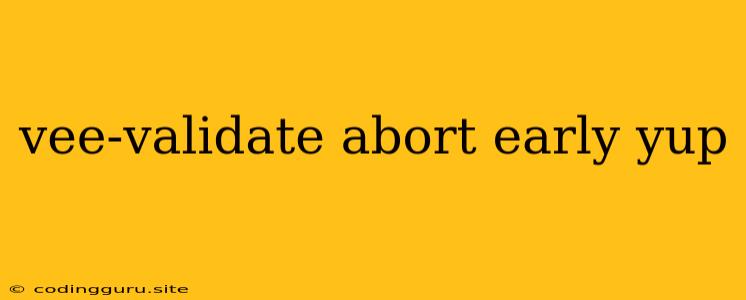Streamlining Form Validation with Vee-Validate, Yup, and Early Abort
Form validation is a crucial aspect of any web application. It ensures data integrity, prevents errors, and improves user experience. While traditional JavaScript validation methods can work, they often become cumbersome and difficult to maintain as applications grow. This is where powerful validation libraries like Vee-Validate and Yup come into play, offering a structured and efficient approach to form validation.
Vee-Validate is a lightweight and highly customizable validation library for Vue.js. It provides a declarative way to validate form inputs using rules and messages, seamlessly integrating with Vue's reactivity system. Yup is a JavaScript schema builder that enables you to define the structure and validation rules for your data.
One common challenge with form validation is handling scenarios where a single field's validation depends on the values of other fields. This can lead to unnecessary validation checks, impacting performance and user experience. Early abort strategies provide a way to optimize form validation by stopping the validation process as soon as an error is found.
Let's delve into how Vee-Validate and Yup work together to implement early abort validation, streamlining the validation process and enhancing your application's performance.
How Does Early Abort Work?
Early abort validation leverages the concept of short-circuiting. Instead of validating all fields in sequence, even if an error is found early on, validation stops immediately at the first error encountered. This prevents unnecessary validation checks, reducing execution time and improving overall efficiency.
Implementing Early Abort with Vee-Validate and Yup
Here's a step-by-step guide to implement early abort validation using Vee-Validate and Yup:
-
Install the Libraries:
npm install vee-validate yup -
Define Your Schema with Yup:
import * as yup from 'yup'; const schema = yup.object().shape({ firstName: yup.string().required('First name is required'), lastName: yup.string().when('firstName', { is: (firstName) => firstName.length > 5, then: yup.string().required('Last name is required'), otherwise: yup.string(), }), email: yup.string().email('Invalid email format'), password: yup.string().required('Password is required'), confirmPassword: yup.string().oneOf( [yup.ref('password'), null], 'Passwords must match' ), });In this example, the
lastNamefield's validation depends on the length of thefirstName. IffirstNameis longer than 5 characters,lastNameis required. This conditional validation is achieved usingyup.when(). -
Integrate Yup Schema with Vee-Validate:
import { ValidationProvider, extend } from 'vee-validate'; import { yupResolver } from '@vee-validate/yup'; extend('yup', yupResolver); // ... your Vue component code ...{{ errors[0] }} This code snippet uses the
yupResolverprovided by Vee-Validate. By extending Vee-Validate with theyupresolver, you integrate your Yup schema directly into the validation process. -
Handling Validation Errors:
// ... your Vue component code ...Vee-Validate automatically manages validation errors, providing a convenient way to display them to the user. The
errorsarray contains the validation messages for each field. You can useerrors.length > 0to check if any errors exist. -
Early Abort in Action:
When you submit the form, Vee-Validate uses the
yupResolverto validate the fields against the Yup schema. The validation process stops as soon as an error is found. For example, if thefirstNamefield is missing, thelastNameand subsequent fields are not validated, significantly improving performance.
Advantages of Early Abort Validation
- Improved Performance: Early abort eliminates unnecessary validation checks, reducing execution time and enhancing user experience.
- Enhanced User Experience: Users get instant feedback as they type, with error messages appearing quickly when errors occur.
- Maintainability: By structuring validation rules with Yup, your code becomes cleaner and easier to maintain.
- Flexibility: You can easily adapt the validation rules based on your application's specific requirements.
Conclusion
Early abort validation with Vee-Validate and Yup provides a powerful and efficient way to manage form validation in your Vue.js applications. By leveraging the capabilities of these libraries, you can streamline the validation process, optimize performance, and create a smooth user experience. The combination of Vee-Validate for declarative validation and Yup for schema-based rules allows you to express validation logic clearly and efficiently.
